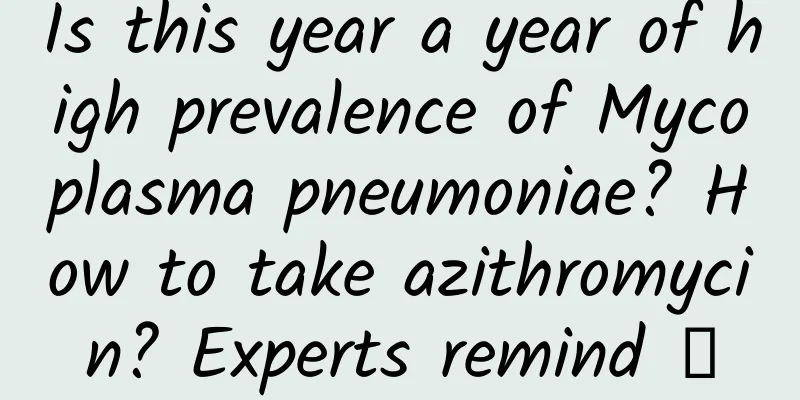Is this year a year of high prevalence of Mycoplasma pneumoniae? How to take azithromycin? Experts remind →

|
Recently, many hospitals in Beijing, Shanghai, Chongqing and other places have seen a large number of patients with Mycoplasma pneumoniae infection, most of whom are children. What are the symptoms of Mycoplasma pneumoniae infection? How is it different from other diseases such as influenza? Are there any sequelae after infection? Written by Zhao Ling, Photo and Text Edited by Chen Yongjie Image source/Visual China Reviewers: Zhi Xiuyi (Chief Expert, Chief Physician, Professor, Department of Thoracic Surgery, Xuanwu Hospital, Capital Medical University) Recently, mycoplasma pneumonia has been trending on the Internet. Many hospitals in Beijing, Shanghai, Chongqing and other places have seen a large number of patients with mycoplasma pneumonia infection, mostly children. A mother said, "There are a lot of people in the children's hospital, and it takes 40 minutes to draw blood." What are the symptoms of mycoplasma pneumonia infection? How is it different from other diseases such as influenza? Are there any sequelae after infection? How should it be prevented and treated? Let's learn and solve the doubts together. Is there a peak in Mycoplasma pneumoniae infection? Parents often bring their children to the pediatric outpatient clinic of the China-Japan Friendship Hospital for medical treatment. Ms. Wang's 10-year-old son had a severe cough and was diagnosed with Mycoplasma pneumoniae infection. According to a pediatrician at the hospital, "recently, there are children hospitalized for severe Mycoplasma pneumonia almost every day." The hospital data reflects the feelings of the citizens: many Beijing citizens do feel that the number of people around them who are coughing and sick has increased significantly recently. Mycoplasma pneumoniae is an important pathogen of acute respiratory tract infection in Beijing. It is divided into two subtypes, type I and type II. Currently, the main subtype prevalent in Beijing is type I. Although most people infected with Mycoplasma pneumoniae are children, in fact, the general population is susceptible to Mycoplasma pneumoniae, and adults should not take it lightly. ▲Recently, parents have been bringing their children to the pediatric outpatient clinic of the China-Japan Friendship Hospital for medical treatment (Photo source: Health Times) As the saying goes, "the right medicine for the right disease", to understand this disease, we must first understand Mycoplasma pneumoniae. In fact, Mycoplasma pneumoniae is neither a bacterium nor a virus, but a pathogenic microorganism between bacteria and viruses, and an atypical pathogen. Mycoplasma pneumoniae has no cell wall structure, like a bacterium without a "coat". How powerful is it? According to the "Guidelines for the Diagnosis and Treatment of Mycoplasma Pneumonia in Children (2023 Edition)" issued by the National Health Commission, mycoplasma pneumonia is the most common community-acquired pneumonia in children aged 5 years and above in my country, with fever and cough as the main clinical manifestations. That's not right. If it's "the most common community-acquired pneumonia in children aged 5 years and above", why did it suddenly dominate the charts this year? Hasn't it been there before? The answer is yes. Mycoplasma pneumoniae infection can occur throughout the year. The peak period of infection in Beijing is from August to December each year, and generally reaches a peak around November each year. However, this year, the pneumonia hit earlier, and the number of patients increased significantly compared with previous years. A pediatrician pointed out that "this year may be a big year for the spread of Mycoplasma pneumoniae." Chen Zhimin, chief physician of the Department of Respiratory Medicine at the Children's Hospital Affiliated to Zhejiang University School of Medicine, said: "Mycoplasma pneumonia is not currently listed as an infectious disease in the world, but like the common cold, it is contagious to a certain extent and is mainly transmitted through droplets. There are related patients every year, but a regional epidemic occurs every 3 to 7 years. The last high incidence rate that attracted attention was in the autumn and winter of 2018." This year, media reports from Beijing, Shanghai and other parts of the country show that the incidence of Mycoplasma pneumoniae infection has been rising since September. Xu Baoping, director of the respiratory department of Beijing Children's Hospital, said that since September, the daily outpatient volume of the fever and cough clinic at Beijing Children's Hospital has increased, and about 20% of the children tested positive for Mycoplasma pneumoniae. As for why the number of people infected with Mycoplasma pneumoniae has increased sharply this year, Peng Jie, director of the Difficult Infection Diagnosis and Treatment Center of Nanfang Hospital of Southern Medical University, believes that during the COVID-19 epidemic, people have been taking measures such as wearing masks, washing hands frequently, and maintaining social distance to prevent the spread of the virus, and have not had the opportunity to come into contact with Mycoplasma pneumoniae. The increase in the susceptible population has led to a deterioration in herd immunity. "Children born in the past three years have not been exposed to many pathogens, so parents should pay special attention." In addition, Peng Jie believes that the feeling that there seems to be a peak in Mycoplasma pneumoniae infection this year may also be related to patients' increased awareness of pathogen detection and the increase in medical testing methods. How to distinguish Mycoplasma pneumoniae infection from COVID-19 and influenza? So, how do you tell if you are infected with Mycoplasma pneumonia? Mycoplasma pneumonia infection has fever and cough as its main symptoms. The cough is usually severe and may continue for 1 to 2 weeks after the fever subsides. Li Shuhua, director of the pediatric outpatient department and fever clinic at Guangzhou Women and Children's Medical Center, reminded that Mycoplasma pneumoniae infection manifests itself in a variety of ways, including high fever that persists, moderate to low fever, pneumonia, atelectasis or pleural effusion, and bronchitis. Because Mycoplasma pneumoniae is more likely to cause irreversible damage to the lungs, its treatment should not be delayed. If a child has a repeated fever for more than three days, it is recommended to go to the hospital for consultation and active treatment. Li Shuhua said that the symptoms of mycoplasma pneumonia are very similar to those of the common cold or influenza. If parents do not pay attention to it in the early stages and buy cold medicine or anti-inflammatory drugs for their children on their own, it will not only be inappropriate and ineffective, but will also delay the best time for treatment. However, respiratory infectious diseases are more likely to occur in autumn and winter, and the symptoms of Mycoplasma pneumoniae infection are easily confused with diseases such as COVID-19 and influenza. How should we distinguish them? Wang Xinyu, deputy director of the Department of Infectious Diseases at Huashan Hospital Affiliated to Fudan University, said that new coronavirus infection and Mycoplasma pneumoniae infection can be distinguished through nucleic acid testing of respiratory specimens. The incubation periods of the two are significantly different, and the incubation period of Mycoplasma pneumoniae is longer. Li Dongzeng, chief physician of the Comprehensive Infection Department of Beijing You'an Hospital, introduced that compared with the common cold, the symptoms of Mycoplasma pneumonia are more severe and last longer. Zhao Shunying, director of the Second Respiratory Department of Beijing Children's Hospital, said that in addition to combining clinical and imaging manifestations as well as etiology and serology tests to make judgments, a simple method is to observe the cough of the child. "The disease generally presents with paroxysmal and clustered coughs, which are dry coughs in the early stage, sometimes affecting eating and sleeping. If the child has symptoms of suffocation and shortness of breath, parents can pat their backs hard to clear the airway, and then go to the hospital as soon as possible," said Zhao Shunying. "The key is timely identification and timely medical treatment." Experts suggest that children infected with Mycoplasma pneumoniae can be cured in a relatively short period of time through methods such as patting the back to expel phlegm, using drugs to eliminate phlegm, and performing bronchoscopy when necessary, with little risk to life. What should I do if I develop azithromycin resistance? The Beijing Center for Disease Control and Prevention previously issued a reminder: Penicillin and cephalosporin are completely ineffective against Mycoplasma pneumoniae. If citizens develop fever accompanied by severe cough, they should seek medical attention in a timely manner, identify the cause and receive standardized treatment as soon as possible, and avoid taking medication blindly. Because Mycoplasma pneumoniae has no cell wall, and familiar antibiotics such as penicillin and cephalosporin use the cell wall as a target, they are completely ineffective against Mycoplasma pneumoniae. The first choice of treatment for Mycoplasma pneumoniae infection is macrolide drugs, such as azithromycin, erythromycin, clarithromycin, etc. But this type of medicine should not be taken casually! For children, there are usually two ways to take azithromycin: three-day therapy and five-day therapy, with 3 days and 5 days as a course of treatment respectively. After the end of a course of treatment, the drug needs to be stopped, with the frequency of "take 3 days and stop 4 days, take 5 days and stop 2 days". Because the terminal elimination half-life of azithromycin is about 68 hours, it can be understood that the drug "resides" in the body for a long time. After 3 days of medication, about half of the drug is still in the body. Moreover, continuous medication is prone to drug resistance. In fact, in recent years, with the widespread use of macrolide drugs in children's respiratory infections, the drug resistance of children infected with Mycoplasma pneumoniae has been on the rise. In the presence of drug resistance, in addition to macrolides, new tetracycline antibiotics can be used as alternative drugs, mainly including doxycycline and minocycline, which have a definite effect on drug-resistant Mycoplasma pneumonia. Another type of alternative drug is quinolone drugs, commonly used are levofloxacin, ciprofloxacin, moxifloxacin, etc. Due to the risk of cartilage damage in young animals and tendon rupture in humans, the use of children under 18 years old in my country is considered off-label use. The drug treatments introduced above must be completed under the guidance of a doctor. Recently, there are many children with concurrent infections, and doctors also need to identify them during diagnosis. Don't take medicine blindly on your own. You must see a doctor in time and follow the doctor's advice. How to prevent Mycoplasma pneumonia? As we are now in the peak period of mycoplasma pneumonia in children, the wards of major children's hospitals are overcrowded. Zhi Xiuyi, chief expert of thoracic surgery at Xuanwu Hospital of Capital Medical University, suggested that families of children with mild symptoms can get infusion medicine at tertiary hospitals, then go to secondary hospitals, community hospitals, etc. for infusion, and then go to tertiary hospitals for reexamination. This can effectively avoid cross infection, and it will be more convenient to infuse in nearby rural health centers, community service centers, etc. Another topic that has attracted much attention is the issue of sequelae, that is, can mycoplasma pneumonia cause "white lung"? Are there any sequelae? Xu Baoping believes that some patients with mycoplasma pneumonia have a white patch on their lungs, which is mostly caused by infection in one lobe or segment, and is different from the medical term "white lung". Generally speaking, "white lung" refers to diffuse lesions in both lungs, which mainly occur in severe infections, and its symptoms and severity are different from mycoplasma pneumonia. Zhang Jie, deputy chief nurse at Beijing Children's Hospital Xiaotangshan Diagnosis and Treatment Center, said: "Mycoplasma pneumonia usually lasts about 2 weeks, and the prognosis is generally good without sequelae. A few may develop into critical illness, often with dyspnea and respiratory failure as prominent manifestations." In general, if your child has been infected with Mycoplasma pneumoniae, don't panic, don't be afraid, seek medical attention in time, and follow the doctor's advice is the best choice. For those who have not been "infected", since Mycoplasma pneumoniae infection is mainly transmitted through droplets, there is currently no vaccine for Mycoplasma pneumoniae infection, so it is very important to do a good job of daily personal protection and develop good personal hygiene habits. Young children and elderly people with weakened immune systems should avoid crowded and poorly ventilated public places, and wear masks when necessary. Cover your mouth and nose with a tissue when coughing or sneezing, or cover your mouth with your elbow or sleeve, and throw the used tissue into a covered trash can. Pay attention to hand hygiene and disinfection. In addition, during the high-incidence season, attention should be paid to indoor ventilation, healthy living habits should be developed, appropriate exercise should be done to increase body resistance, and attention should be paid to keeping warm and avoiding cold. Schools, kindergartens and other key places should pay attention to ventilation and disinfection, do a good job of daily cleaning, strengthen health monitoring, and avoid clustered infections. |
<<: Is it true that the sun once had a twin?
Recommend
Osteoporosis is caused by sun protection? Causes of osteoporosis for office workers +1
Audit expert: Zhang Yuhong Chief Physician of Der...
Oppenheimer swept the Oscars! He is not only the father of the atomic bomb
Oppenheimer, the "father of the atomic bomb&...
What is Fuchsia, the successor to Android?
There is no need to say much about the success of...
Things that can cause miscarriage if a pregnant woman touches them: When is it easy for website optimization content to be indexed by search engines?
There is no doubt that the key to website optimiz...
Wang Hao's new posture correction-posture assessment and rehabilitation
Wang Hao's new body correction - body assessm...
How to write a promotion plan for new media operations?
Introduction: How does a new media director write...
30 high-quality cases of information flow advertising in 15 industries for your reference!
One month has passed in 2018. We often say: Once ...
Teach you how to open the Douyin "product showcase" step by step
There are three ways to monetize Douyin: product ...
Using drones to provide Internet services? Unfortunately, Google and Facebook have failed
The scenario sounds like science fiction: autonom...
Why aren’t copycat cell phones dead yet?
Around 2008, a wave of "copycat mobile phone...
4 classic routines for brand marketing in 2020
As the pages of the December calendar turn, it in...
Leave no way for "ice cream assassins" to escape! These seven behaviors are prohibited
This summer, the term "ice cream assassin&qu...
How to create a fresh food mini program? How much does it cost to make a fresh food mini app?
Fresh food mini-programs are very popular nowaday...
WeChat's new version has huge changes! Is it going to become a live broadcast software?
WeChat has been updated again. Although this vers...
What killer applications have emerged in the mobile Internet in the past decade?
If Apple and Google hadn't added an app store...









